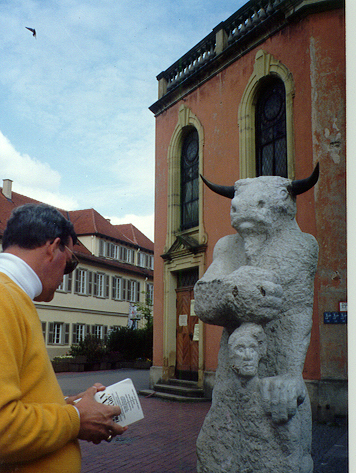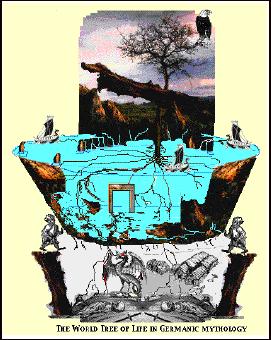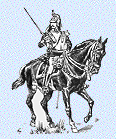German-Russian myths about the supernatural, superstitions, witches, merlins, ghosts, fairies, and other phenomena.....
Last Updated: 31 Aug 2003
With the "Germanic tribes" arrived their nordic gods.
It was Caesar who comments on the Germanic cult [religion]:
"They have no Druids to control religious observance and are not much given to sacrifices. The only beings that they recognize as gods are things that they can see, and by which they are obviously assisted; the sun, the moon and fire; the others they have never heard...." Of course, the Germanic religion wasn't as simple as Caesar had described. There were priests but their rank was lower than the shamans, known also as merlins, who interpreted the will of the gods and were very much like Merlin in the tale of King Arthur was a merlin. It is Tacitus who gives us more detail about the Germanic religion. "They worship Mercury more than any other of the gods. They do not think it wrong to propitiate him on certain days with human sacrifices. Hercules and Mars they appease with more venial sacrifices. A port of the Suebi also sacrifice to Isis... they consider that it ill accords with the majesty of heavenly being to coop them within walls or depict them in any human shape. They consecrate groves and woods and give divine names to that mysterious abstraction which they see by the eye of awe alone."
The ancients [early Germanic peoples] believed there was a time when there was no earth or heaven. There was an abyss or empty place called Ginnungagap, which was a region located between the other two regions known Muspell and to the north was Niflheim. Muspell was a place which had scorching heat and had huge glowing embers because it was always burning. The god who ruled with a flaming sword was Surte. Niflheim was Muspell's opposite and consisted of bitter winds that held the ice and snow in freezing temperatures. Here was the frozen water of the eleven rivers of Hvergelmir. In Nifheim, Cold and Darkness ruled. All was in order. While all was in order there was little changed. . What was once an abyss was invaded by a slow flowing icy stream called Elivagor. Then suddenly everything changed. The flowing ice of Elivagor collided with the scorching heat and fire of Muspell. The frozen stream began to melt in the Ginnungagap which was no longer an empty abyss and a warm mist collected. Everything had changed and what had been was no longer the same. There was great chaos. Life began in the first drops of chaos.

Garry Hubert looking at an artists interpretation of Yamir, the Giant, and the Cow, found in German mythology.
Ludwigsburg, Germany
Remmick-Hubert Collection, 1991
The first creature created was Ymir the giant and Audumbla, the cow, who's milk fed the giant. The cow was able to live by licking the ice. From Ymir's armpit was created the first man and woman who gave life to the three fates Urd, Verdandi and Skuld and later to them came the wise Mimer. Ymir's legs gave birth to a son. From his feet were created a monster with three heads who was the ancestor of the evil giant family called Rimtusarnas. After three nights the drops of chaos created Buri... his son Bor who married Bestla.... There is no words on how she was created. They had three sons Odin, Vili and Ve who hated Ymir the giant and killed him. They took Ymir's body to the center of Ginungagap and with Ymir's body parts created the world. With Ymir's flesh they created the earth by grinding it at the great mill known as Grottekvarnen which they shaped into a spherical form. The mill was Fenja and Menja, two giantesses. Ymer's unbroken bones were used create the mountains. They shattered the rest of the bones and and teeth. From this they created boulders, rocks and pebbles. Ymir's blood became the flowing rivers, lakes and seas. Ymir's skull became the sky. As the three worked on the earth maggots appeared from the rotting carcass of Ymir's. The three turned the maggots into four dwarfs [Nordri, Sudri, Austri and Bestri] who were placed to hold up the four corners of the earth. The three took from Muspellheim flowing embers and fashioned them into orbs of light [the sun, moon and stars] which were placed into the sky. Ymir's brains also were ground up in the great mill and were made into clouds. Ymir's brow was later turned into a wall....
It was time to name parts of the world they created. Jotunheim was created for the giants of frost and rock. The region called Midgard [Middle Place] was for the mortals, who needed protection of the wall which had once been Ymir's brow... The regions "Down Under" were Mimer's, Urda's and Hvergelmer's. Each had their own well. Urda's well was guarded by the three fates. Miner's well held wisdom. In Hvergelmer region was the dragon Nidhoog who gnawed on the roots of the Ygdrasil, an ash [oak] tree known as the Tree of Life.

The World Tree of Life in Germanic Mythology.
It was Odin who created he first two mortals from two fallen trees, an Ash and an Elm. And then Odin gave these mortals the essence of life [thoughts, emotions, hearing, speech and the ability to see]. He called them Ask and Embla. All mortals are their descendants...
The three gods [Odin, Vili and Ve] created the means to measure and record time by making Night and Day...
When this was completed the gods set up the fate of the earth. When both the son and moon were devoured by the wolves, it would be at that moment the Battle of Ragnarok [Doomsday] would begin and the world they had created would end.

Borodino Home Site |
Hubert Home Site
|
Remmick Home Site Your Are Here |
Edenkoben. Home.Site |